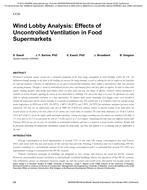Description
Mechanical ventilation systems account for a substantial proportion of the total energy consumption of retail buildings within the UK. Air infiltration through openings in the fabric of the building can increase the energy demands, as well as reducing the level of comfort on the shop floor for staff and customers. Entrances in supermarkets are an aspect of uncontrolled ventilation, where airflow is determined by door sizes, positions and opening frequency. Draught is caused by wind-induced pressure forces and buoyancy forces and these often act together. In order to reduce their impact, building designers often specify wind lobbies, which are often costly and may not always be effective. However, limited information is available in current literature regarding the success of such wind lobbies in buildings. The aim of this study is to assess the effectiveness of a wind lobby in reducing uncontrolled ventilation in a food supermarket. To improve upon current knowledge, data logging sensors were installed to monitor the temperature and the relative humidity in a centrally air-conditioned store. The selected store is in Yorkshire, where the recorded average winter temperatures in 2010 were 4.10°C (39.38°F), -1.00°C (30.20°F), and 1.50°C (34.70°F) for maximum, minimum and mean values respectively. The store has an approximate sales area of 5000 m2 (53820 ft2); however, because of concerns relation to the wind lobby, the research focuses on the front of the store, where an air curtain and a wind lobby are installed. The wind lobby dimensions are 10 x 5.3 x 4 m (32.8 x 17.4 x 13.1 ft) for the length, width and height respectively. Tinytag data loggers recording every two minutes are installed in the lobby at 1.1 (3.6) and 2.2 m (7.2 ft) and inside the store at 1 (3.28) and 2.2 m (7.2 ft) heights. Monitoring will take place over different seasons from February 2012 for one year to assess the variability in uncontrolled ventilation and how it is related to external weather conditions. Results will be presented concerning the temperature distribution around the wind lobby, and thus how effective it is in reducing cold air infiltration to the store.
Citation: Cold Climate Conference, 2012
Product Details
- Published:
- 2012
- Number of Pages:
- 8
- File Size:
- 1 file , 1.4 MB
- Product Code(s):
- D-CCC12-50
